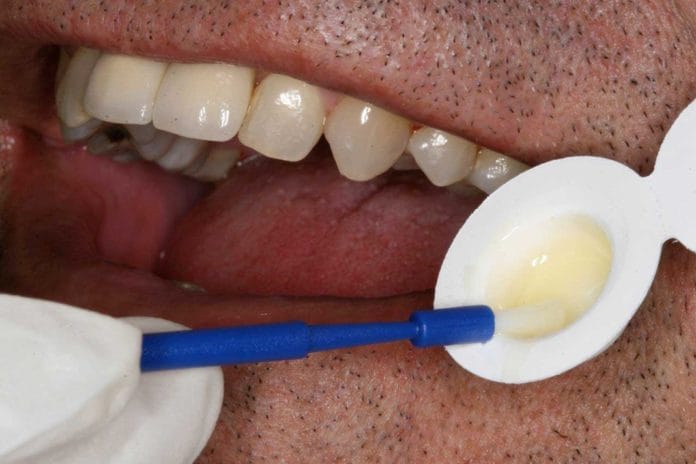A patient comes in and with a chief complaint of extremely sensitive teeth. It’s painful to drink a cold beverage or eat their favorite ice cream. They even struggle with the simple act of brushing their teeth. You know the answer to their problems and so does every dental hygienist across the nation: Fluoride. Whether you have patients that are suffering from sensitive teeth or at high risk of dental caries, fluoride is highly effective. However, when it comes to applying this solution, not every dental office will opt for the best form of fluoride. Many still rely on fluoride foam for fluoride treatments. When it comes to research, the evidence is showing time and time again that fluoride varnish far outweighs the efficacy of fluoride foam.
Fluoride Varnish: A History
For nearly 50 years, dental professionals have been employing the power of fluoride. Stannous fluoride came first, next gel appeared on the market, and then foam was introduced. With each version of fluoride, an improvement was made. It became less messy to apply, it tasted a little bit better, and it started to be more convenient to apply. A quarter of a century ago, countries like South Africa, Canada, and the United Kingdom embraced the newest version of fluoride: Varnish. A few years later, in 1994, America’s FDA approved fluoride varnish for the treatment of sensitive teeth. In addition to this, many dental professionals across the United States, who stayed abreast of the latest research, chose to use fluoride varnish “off-label” because of its usefulness in preventing dental caries.
Fluoride Varnish: The Benefits
The basic benefits of fluoride are clear and have been proven over and over again. However, when it comes to specifically looking at fluoride varnishes, as distinguished from foam fluoride application, some dental professionals are unaware of the numerous advantages.
Ease of Application
One of the biggest benefits to both dental professionals and patients is how quickly fluoride varnish can be applied and how easy it is to apply it. Application training is minimal and due to how efficient the varnish application method is, less treatment time can be spent applying it. This allows for more time during a patient’s appointment to scale, explain recommended treatment, review OHI, answer patient questions, take radiographs, perform oral cancer screenings, or any other important piece to the appointment that needs to be completed within the appointment time.
Long-Term Effectiveness
A second significant advantage to fluoride varnish can be seen very clearly in research studies. When fluoride varnish is compared to fluoride foam with computer imaging, over several weeks, it becomes apparent that the level of efficacy that varnish provides is far superior. In one study, the two methods were compared head-to-head. One week after the two methods were applied to study participants’ teeth, no significant statistical difference could be identified. However, just one week later, researchers found it was clear that varnish gives significantly better long-term protection to teeth than foam. This finding can be applied to every fluoride varnish application from early decalcification in primary dentition to recently erupted permanent teeth to even white spot lesions.
When it comes to the effectiveness of varnish versus foam, dental professionals need to be aware of comparisons of dental caries reductions rates. On average, studies have found that foam only reduces caries by about 25% in adults and adolescents and around 40% for children. In comparison, varnishes reduce dental caries by anywhere from 50% to 70% across the board. For individuals who are moderate to high-risk for dental caries, this additional 45% can make a massive difference in long-term dental care.
Levels of Fluoride
Another potential benefit is the higher concentration of fluoride that varnishes contain when compared to foams. When a large enough longitudinal study is completed, it could show that the more concentrated form of fluoride in varnishes gives this application method additional efficacy.
Duration of Treatment
Beyond the benefit of enhanced remineralization with varnish, it is also ten times as effective at lessening the amount of cariogenic bacteria, S. mutans. Fluoride foam, on the other hand, is less effective at fighting S. mutans than a simple chlorhexidine mouthwash. Fluoride varnish extends its efficacy through the fact that it is sticky. This means that it will remain on the tooth for much longer than foam, allowing the patient to eat and drink soon after application while also allowing the fluoride to continue being absorbed by the tooth. But while the varnish does stick well to teeth, it also dries quickly and is not negatively affected if saliva is present, making the whole process easier for both the dental hygienist and the patient. In fact, when the varnish comes into contact with saliva it hardens and can stay on the tooth and continue to be absorbed for up to seven days. Foam fluorides, on the other hand, will only remain on the tooth for roughly 15 minutes.
Lower Risks
Then there is the advantage of being able to use fluoride varnish without having the risk of dental fluorosis, which can not only discolor the teeth but also cause physical damage. Because the varnish is applied directly to the teeth, it is able to set very quickly. This stickiness allows the varnish to adhere to the teeth, and not only is less of the substance used but the minimal amount that is used is less likely to be swallowed than fluoride foam.
This reduction in the risk of swallowing fluoride also enables dental practitioners to apply fluoride to children under the age of 6, which is not safe with other fluoride application methods such as fluoride foam. In fact, applying fluoride varnish to children’s teeth is so safe that the United States Preventative Services Task Force has recommended to primary care physicians that, in an effort to prevent dental caries, they should apply fluoride varnish to all of the primary teeth of children under the age of five.
Child-Friendly
Another aspect of fluoride varnish that makes applying fluoride on children’s teeth easier for a dental professional and more comfortable for the child is the fact that the varnishes come in many different flavors. The American Academy of Pediatrics recommends fluoride varnish treatments beginning at initial tooth eruption.
Gag Reflex-Friendly
Alongside the advantage of fluoride application to young children, individuals who suffer from a strong gag reflex may also utilize the powerful effects of fluoride application. Previously, with fluoride foam, dental hygienists had to use a tray for application. With fluoride varnish, however, the tray is no longer necessary, and the fluoride can be applied directly to the teeth.
Bioavailability
Besides the potential of a gag reflex and the possibility of dental fluorosis, dental hygienists must keep in mind other harmful effects that the various forms of fluoride could have on the body. The easiest way to gauge these potential effects is through the measurement of bioavailability, or the amount of a substance that is introduced into circulation when applied to any part of the body, allowing it to actively affect the body. The bioavailability of fluoride varnishes is minimal, meaning that it will have little or no effect on the rest of the body. Foams, on the other hand, can have a much higher rate of bioavailability. In other words, even though the concentration of fluoride ion is higher in varnish, less is swallowed than with fluoride foam. Again, making it safer for very young children and adults alike.
Cost-Effectiveness
There is also the matter of cost-effectiveness. Dental practices are businesses after all, and employees in these businesses must be aware of the cost and reward of various services. As previously stated, the fluoride varnish takes significantly less time to apply. Additionally, in a Canadian study, researchers found that varnish application made fewer patients sick and uncomfortable. Less time and labor applying the varnish paired with happier patients provide a clear indication of fluoride varnish having greater cost-effectiveness than fluoride foam. A Finnish research study concurred with this after finding a ratio of 1.8 over four years for fluoride varnish when it comes to cost-effectiveness.
The cost-effectiveness of fluoride varnish is extended even further when looking at how fluoride varnish is packaged versus how fluoride foam is packaged. Fluoride foam is nearly always packaged in a single, large foam-dispensing bottle. The dental practitioner can dispense as much foam as they see fit. However, the frame of mind is often that the mouth tray should have more than enough foam rather than less, simply to ensure that every tooth is properly coated for the duration of the treatment. More times than not, too much foam is used, which then must be chalked up as waste. On the other hand, with many fluoride varnish treatments, the varnish comes in a unit-dose package. Each patient gets exactly the right amount, meaning that less of the product is wasted and money is saved.
Recommendations from Experts
On top of all of the evidence is the simple fact that there is little to no evidence behind the efficacy of fluoride foams, which is quite the opposite of fluoride varnish. The ADA recommends fluoride varnish over foam for children under six years of age, not only due to efficacy but the risks (ingestion) outweighing the benefits.
At the end of the day, the research speaks for itself. Fluoride varnish has greater efficacy when it comes to accomplishing what it is meant to accomplish: Treating sensitive teeth and reducing the rate of dental caries. But along with being more effective than fluoride foam, fluoride varnish is also more cost-effective and safer to use.











